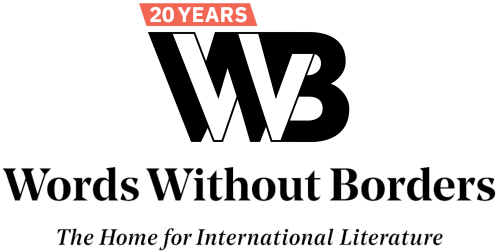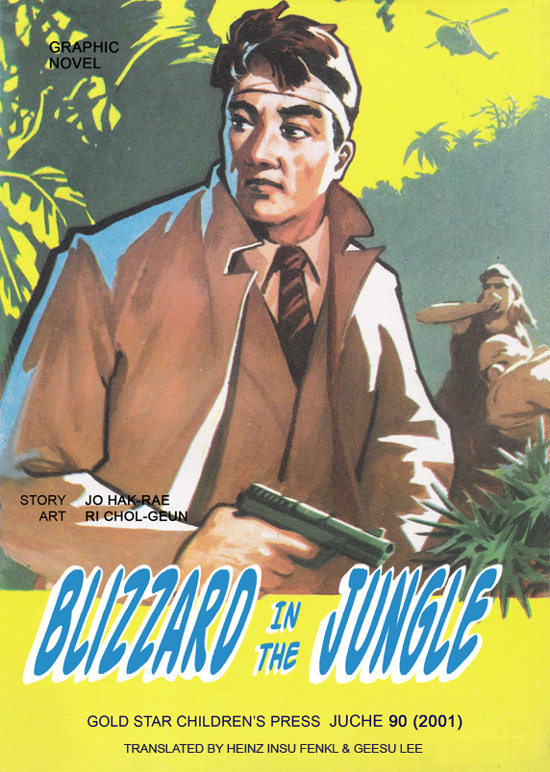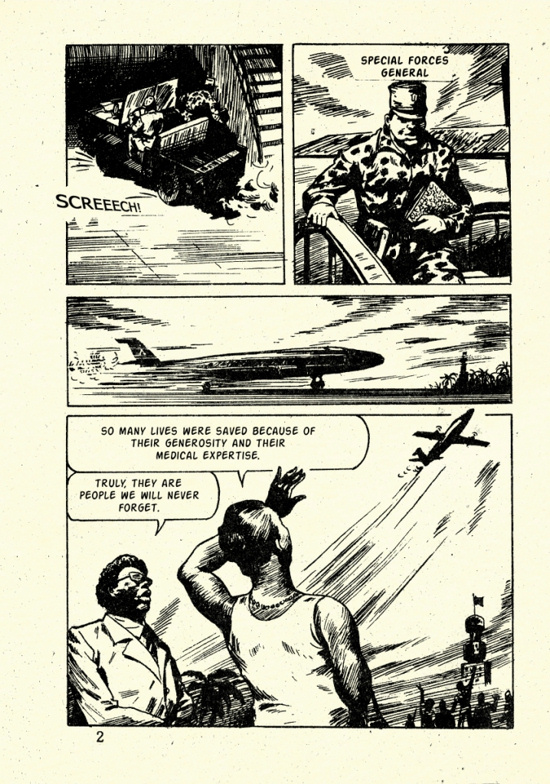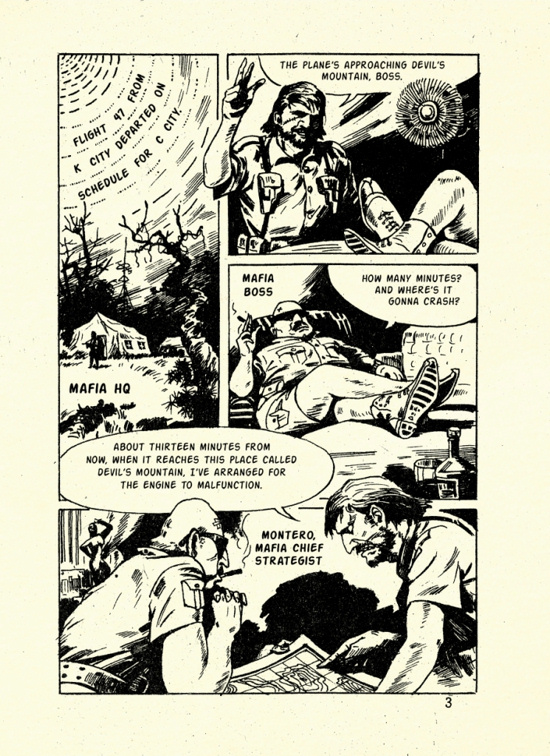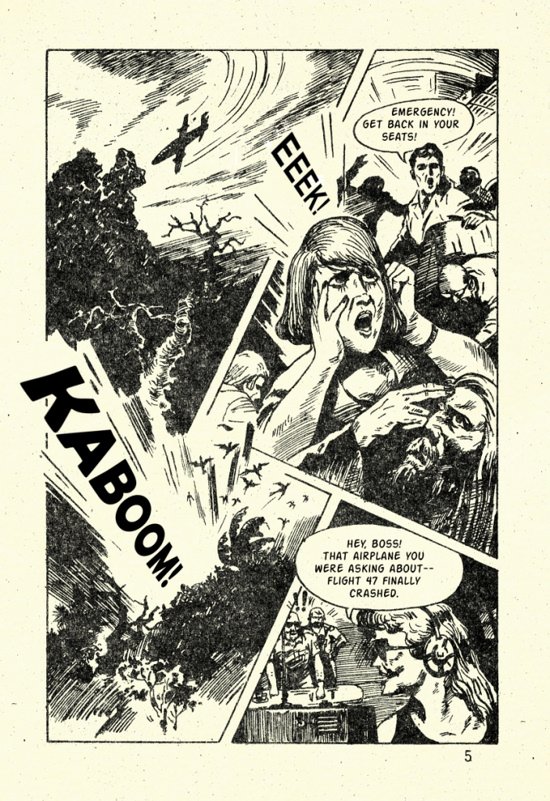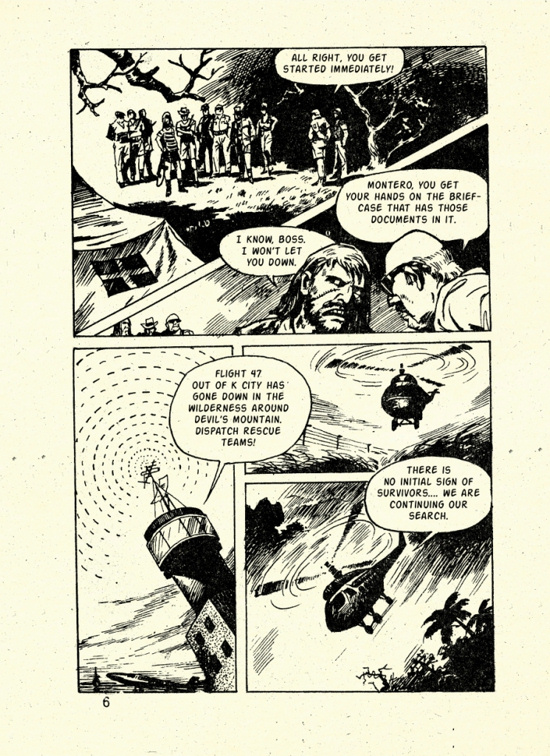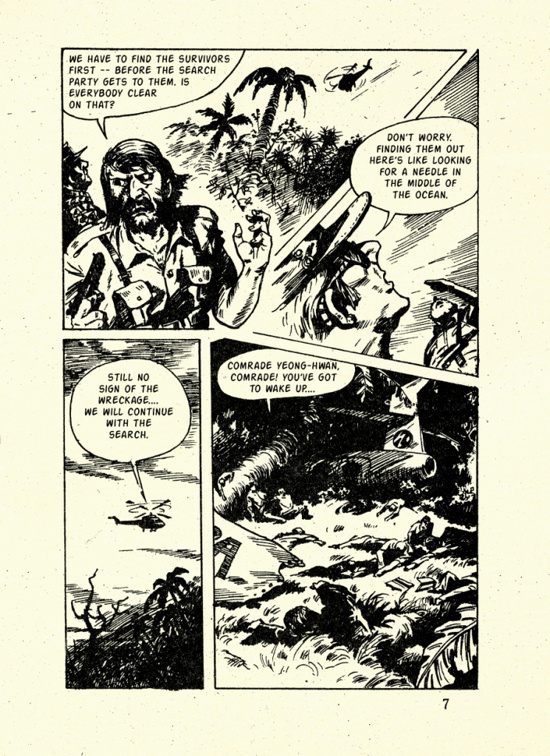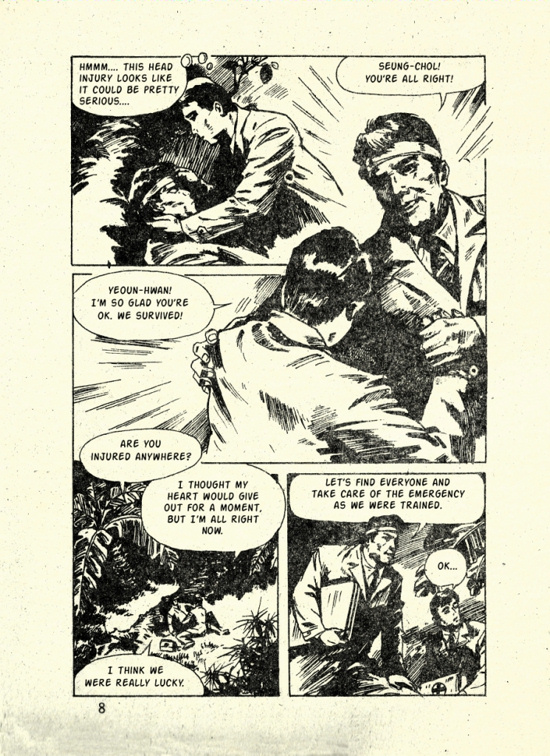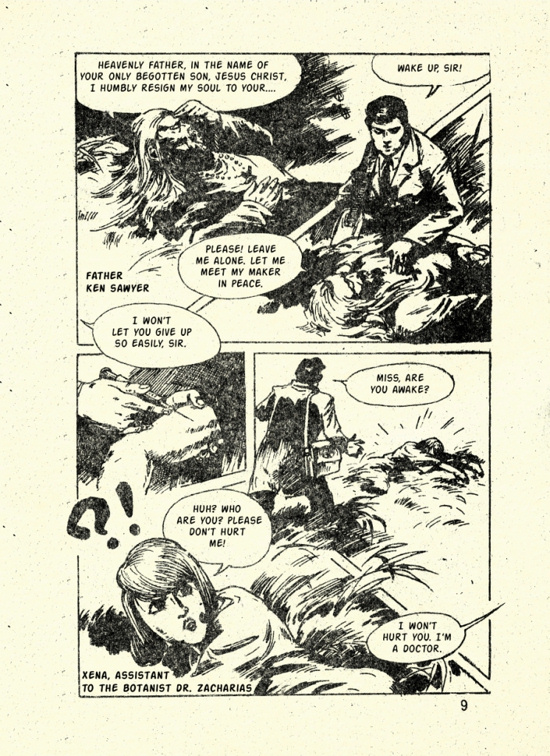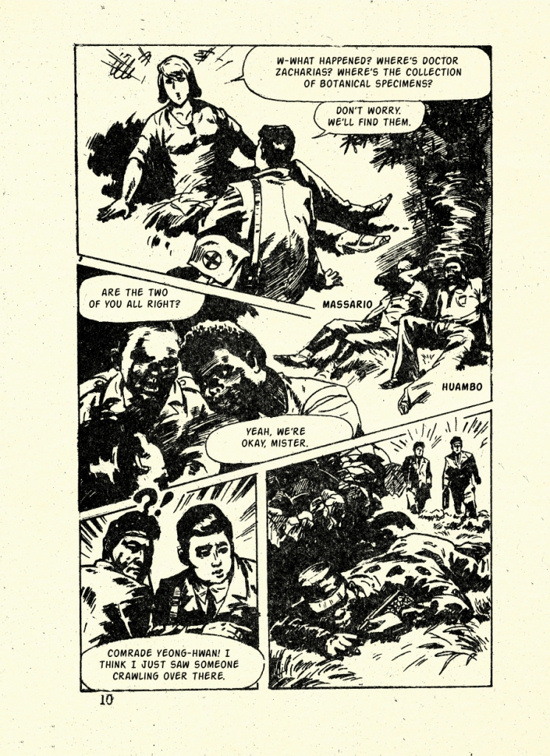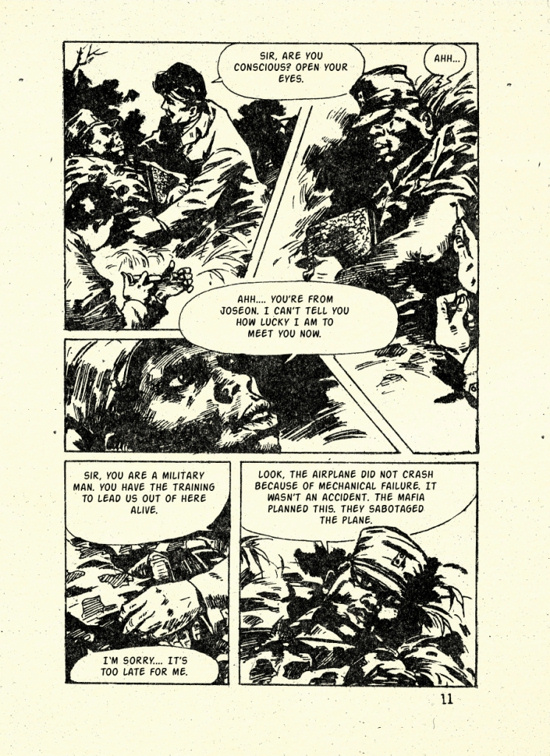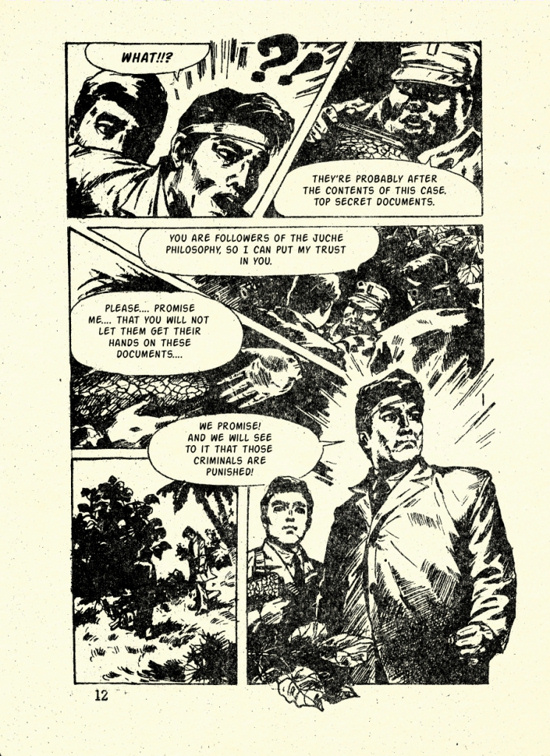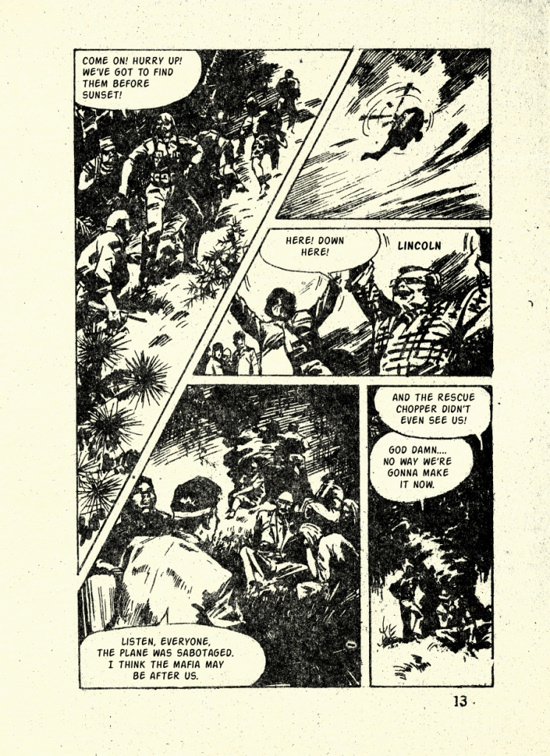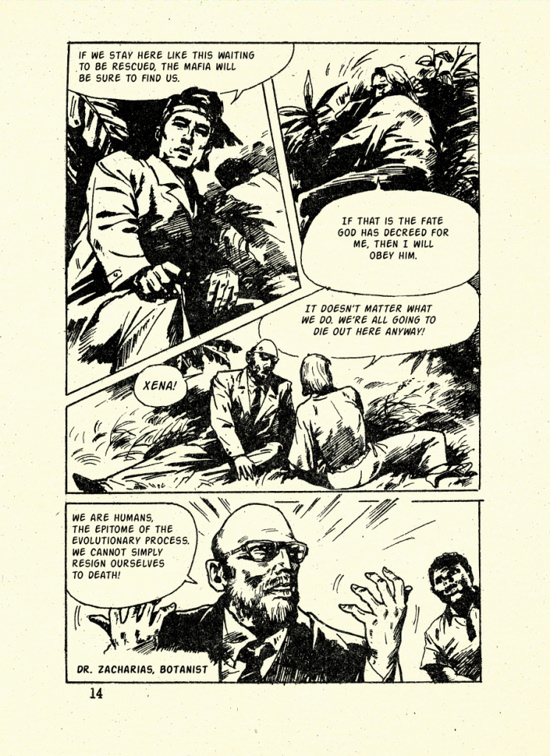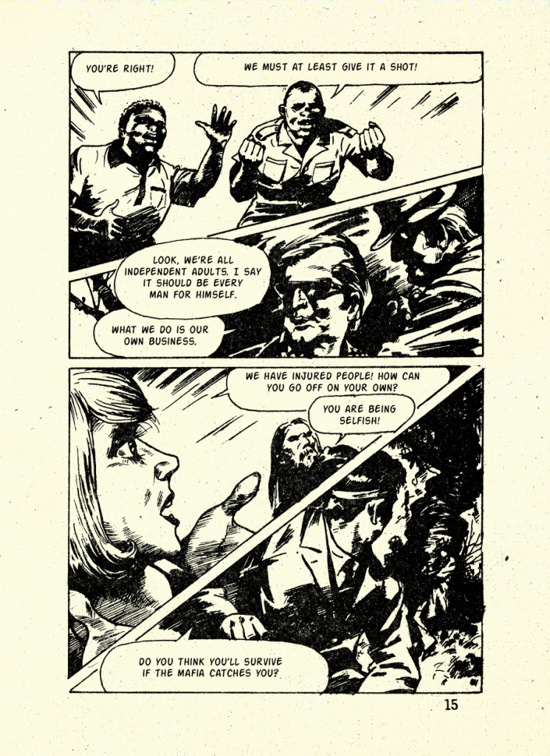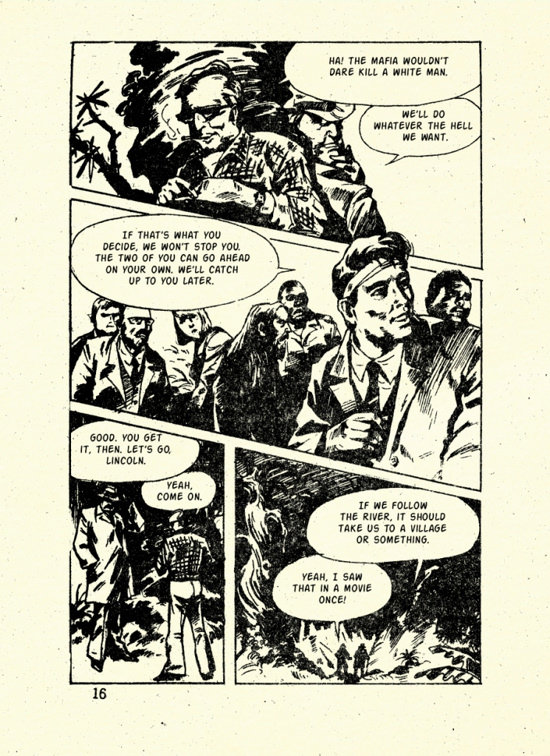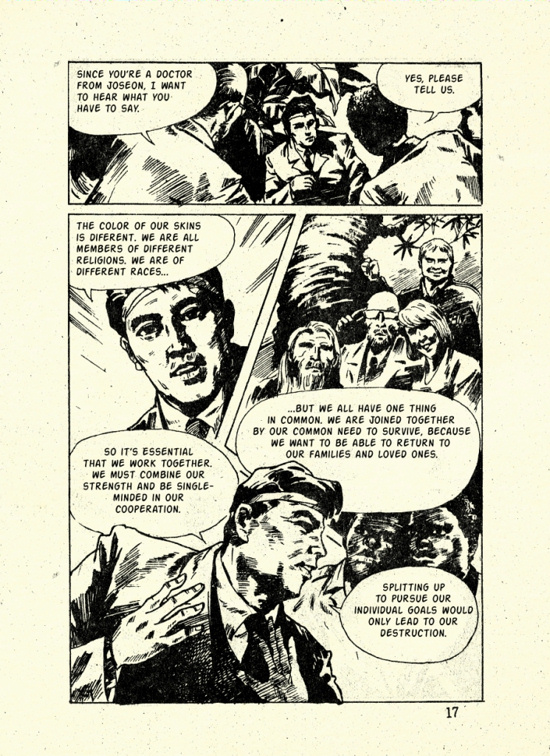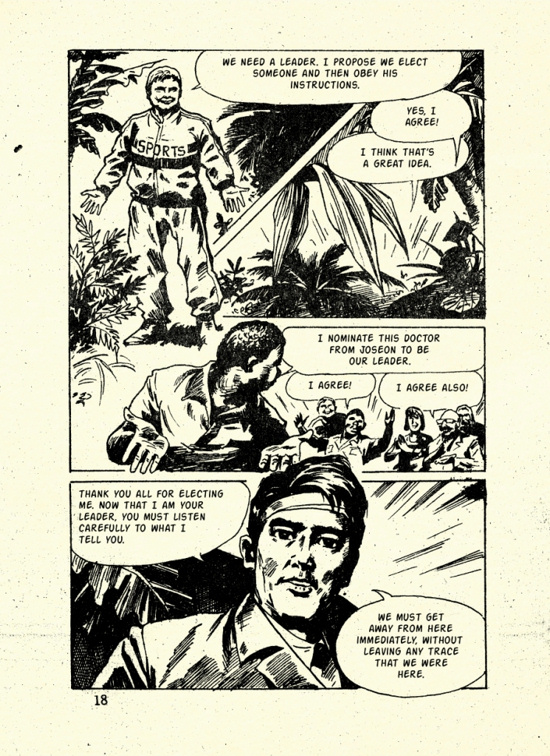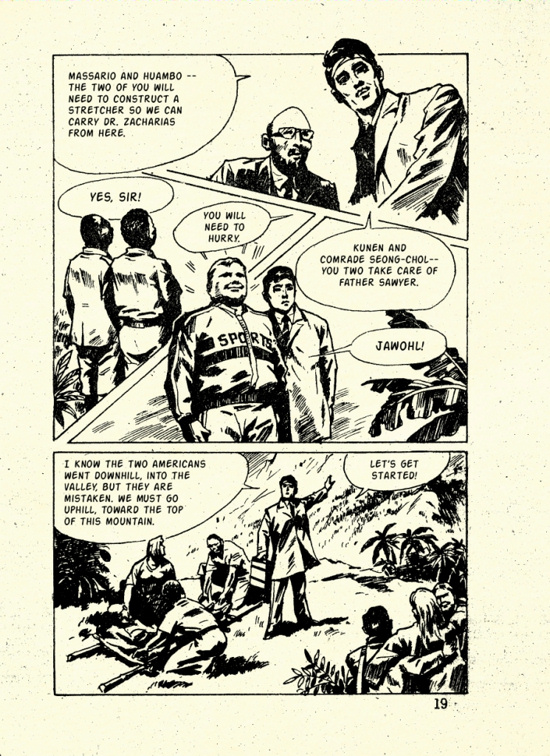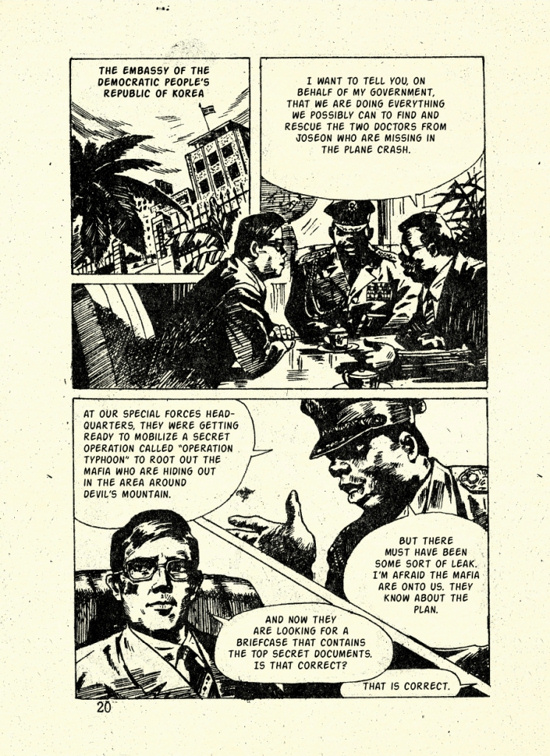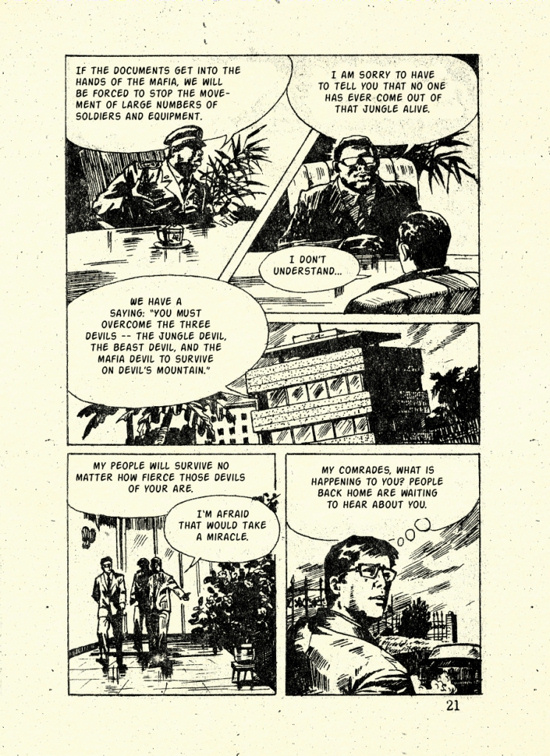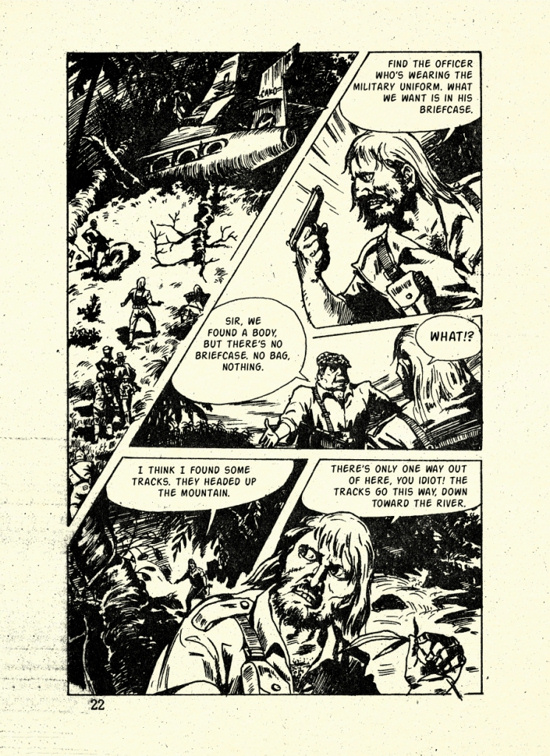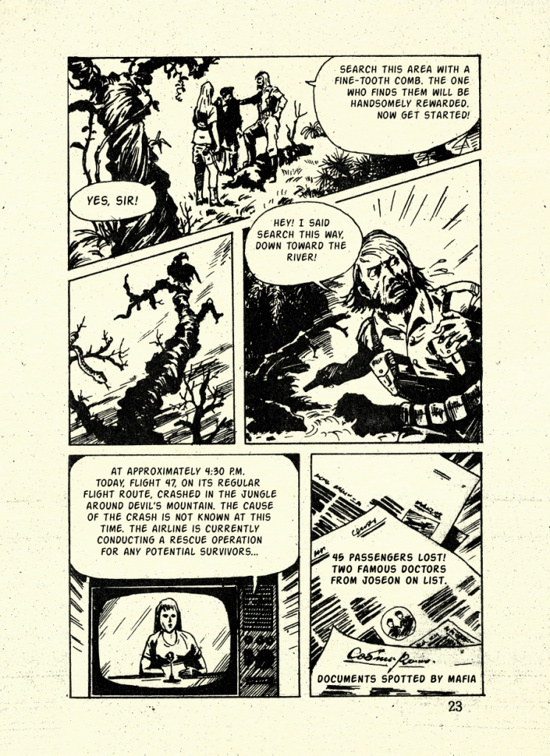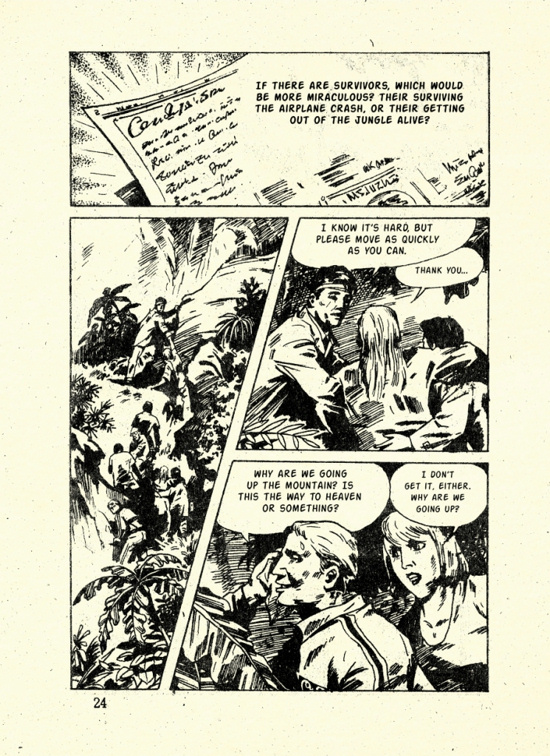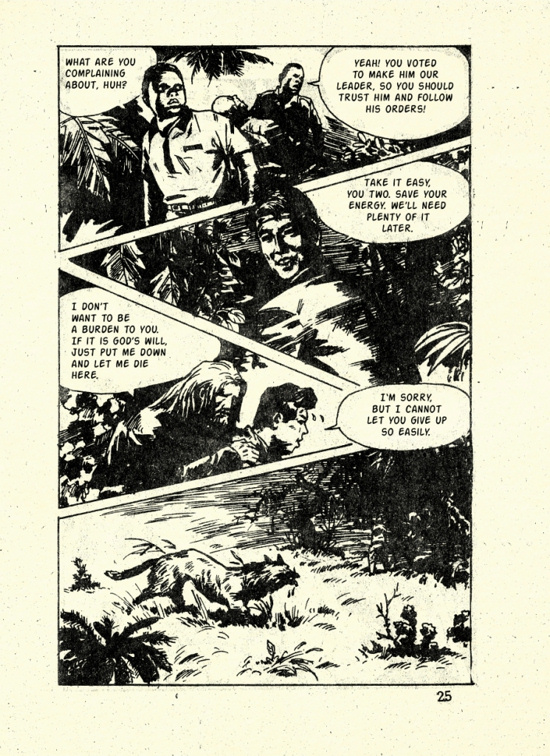GRAPHIC NOVEL
STORY JO HAK - RAE ART RI CHOL - GEUN
BLIZZARDJUNGUS THE GOLD STAR CHILDREN'S PRESS JUCHE 90 ( 2001 ) TRANSLATED BY HEINZ INSU FENKL & GEESU LEE
OUR STORY BEGINS MANY YEARS AGO , AT AN AIRPORT IN A COUNTRY IN AFRICA ...
[Frame]
GOOD - BYE !
SEONG - CHEOL & YEONG - HWAN: TILL WE MEET AGAIN
SEONG - CHEOL KIM
YEONG - HWAN KIM
[Frame]
WE APPRECIATE YOUR HARD WORK ! GOOD - BYE !
[Frame]
{HONK! HONK!}
{SCREEECH !}
[Frame]
SPECIAL FORCES GENERAL
Person 1: SO MANY LIVES WERE SAVED BECAUSE OF THEIR GENEROSITY AND THEIR MEDICAL EXPERTISE .
Person 2: TRULY , THEY ARE PEOPLE WE WILL NEVER FORGET .
Flight 47 From K City Departed on Schedule for C City
MAFIA HQ
Montero: THE PLANE'S APPROACHING DEVIL'S MOUNTAIN , BOSS .
MAFIA BOSS: HOW MANY MINUTES ? AND WHERE'S IT GONNA CRASH ?
MONTERO , MAFIA CHIEF STRATEGIST: ABOUT THIRTEEN MINUTES FROM NOW , WHEN IT REACHES THIS PLACE CALLED DEVIL'S MOUNTAIN , I'VE ARRANGED FOR THE ENGINE TO MALFUNCTION .
People in Plane: WOW , IT'S REALLY AWFUL DOWN THERE .
People in Plane: I HEARD THAT NO ONE'S EVER MADE IT OUT OF THAT JUNGLE ALIVE .
People in Plane: IT'S TOO QUIET . YOU'RE SO GOD DAMNED NOSY .
People in Plane: ARGH ! MAYDAY ! MAYDAY ! OUR ENGINES ARE OUT ! AH ! OUR RADIO'S NOT WORKING , EITHER !
People in Plane: EEEK !
Man on Plane: EMERGENCY ! GET BACK IN YOUR SEATS !
{KABOOM !}
Mafia worker: HEY , BOSS ! THAT AIRPLANE YOU WERE ASKING ABOUT- FLIGHT 47 FINALLY CRASHED .
MAFIA BOSS: ALL RIGHT , YOU GET STARTED IMMEDIATELY !
MONTERO: I KNOW , BOSS . I WON'T LET YOU DOWN .
MAFIA BOSS: MONTERO , YOU GET YOUR HANDS ON THE BRIEF CASE THAT HAS THOSE DOCUMENTS IN IT .
Air control tower: FLIGHT 47 OUT OF K CITY HAS GONE DOWN IN THE WILDERNESS AROUND DEVIL'S MOUNTAIN . DISPATCH RESCUE TEAMS !
Helicopter workers: THERE IS NO INITIAL SIGN OF SURVIVORS .... WE ARE CONTINUING OUR SEARCH .
MONTERO: WE HAVE TO FIND THE SURVIVORS FIRST BEFORE THE SEARCH PARTY GETS TO THEM . IS EVERYBODY CLEAR ON THAT ?
Man: DON'T WORRY . FINDING THEM OUT HERE'S LIKE LOOKING FOR A NEEDLE IN THE MIDDLE OF THE OCEAN .
Helicopter workers: STILL NO SIGN OF THE WRECKAGE .... WE WILL CONTINUE WITH THE SEARCH .
Airplane survivor: COMRADE YEONG - HWAN , COMRADE ! YOU'VE GOT TO WAKE UP .....
Airplane survivor: HMMM .... THIS HEAD INJURY LOOKS LIKE IT COULD BE PRETTY SERIOUS ....
YEOUN - HWAN: SEUNG - CHOL ! YOU'RE ALL RIGHT !
SEUNG - CHOL: YEOUN - HWAN ! I'M SO GLAD YOU'RE OK . WE SURVIVED !
YEOUN - HWAN: ARE YOU INJURED ANYWHERE ?
SEUNG - CHOL: I THOUGHT MY HEART WOULD GIVE OUT FOR A MOMENT , BUT I'M ALL RIGHT NOW .
YEOUN - HWAN: I THINK WE WERE REALLY LUCKY .
YEOUN - HWAN:LET'S FIND EVERYONE AND TAKE CARE OF THE EMERGENCY AS WE WERE TRAINED .
SEUNG - CHOL: OK ...
FATHER KEN SAWYER: HEAVENLY FATHER , IN THE NAME OF YOUR ONLY BEGOTTEN SON , JESUS CHRIST , I HUMBLY RESIGN MY SOUL TO YOUR ....
I WON'T LET YOU GIVE UP SO EASILY , SIR .
SEUNG - CHOL: WAKE UP , SIR !
FATHER KEN SAWYER: PLEASE ! LEAVE ME ALONE . LET ME MEET MY MAKER IN PEACE .
SEUNG - CHOL: MISS , ARE YOU AWAKE ?
XENA , ASSISTANT TO THE BOTANIST DR . ZACHARIAS: HUH ? WHO ARE YOU ? PLEASE DON'T HURT ME !
SEUNG - CHOL: I WON'T HURT YOU . I'M A DOCTOR .
XENA: W - WHAT HAPPENED ? WHERE'S DOCTOR ZACHARIAS ? WHERE'S THE COLLECTION OF BOTANICAL SPECIMENS ?
SEUNG - CHOL: DON'T WORRY . WE'LL FIND THEM .
MASSARIO: ARE THE TWO OF YOU ALL RIGHT ?
HUAMBO: YEAH , WE'RE OKAY , MISTER .
SEUNG - CHOL: COMRADE YEONG - HWAN ! I THINK I JUST SAW SOMEONE CRAWLING OVER THERE .
SIR , ARE YOU CONSCIOUS ? OPEN YOUR EYES .
MILITARY MAN: AHH ...
MILITARY MAN: AHH ..... YOU'RE FROM JOSEON . I CAN'T TELL YOU HOW LUCKY I AM TO MEET YOU NOW .
SIR , YOU ARE A MILITARY MAN . YOU HAVE THE TRAINING TO LEAD US OUT OF HERE ALIVE .
MILITARY MAN: I'M SORRY .... IT'S TOO LATE FOR ME .
LOOK , THE AIRPLANE DID NOT CRASH BECAUSE OF MECHANICAL FAILURE . IT WASN'T AN ACCIDENT . THE MAFIA PLANNED THIS . THEY SABOTAGED THE PLANE .
YEOUN - HWAN: WHAT !! ?
MILITARY MAN: THEY'RE PROBABLY AFTER THE CONTENTS OF THIS CASE , TOP SECRET DOCUMENTS .
MILITARY MAN: YOU ARE FOLLOWERS OF THE JUCHE PHILOSOPHY , SO I CAN PUT MY TRUST IN YOU .
PLEASE ... PROMISE ME .... THAT YOU WILL NOT LET THEM GET THEIR HANDS ON THESE DOCUMENTS ....
YEOUN - HWAN: WE PROMISE ! AND WE WILL SEE TO IT THAT THOSE CRIMINALS ARE PUNISHED !
MONTERO: COME ON ! HURRY UP ! WE'VE GOT TO FIND THEM BEFORE SUNSET !
LINCOLN: HERE ! DOWN HERE !
YEOUN - HWAN: LISTEN , EVERYONE , THE PLANE WAS SABOTAGED . I THINK THE MAFIA MAY BE AFTER US .
LINCOLN: AND THE RESCUE CHOPPER DIDN'T EVEN SEE US !
GOD DAMN .... NO WAY WE'RE GONNA MAKE IT NOW .
YEOUN - HWAN: IF WE STAY HERE LIKE THIS WAITING TO BE RESCUED , THE MAFIA WILL BE SURE TO FIND US .
FATHER KEN SAWYER: IF THAT IS THE FATE GOD HAS DECREED FOR ME , THEN I WILL OBEY HIM .
XENA: IT DOESN'T MATTER WHAT WE DO . WE'RE ALL GOING TO DIE OUT HERE ANYWAY !
DR . ZACHARIAS , BOTANIST: XENA !
DR . ZACHARIAS: WE ARE HUMANS , THE EPITOME OF THE EVOLUTIONARY PROCESS . WE CANNOT SIMPLY RESIGN OURSELVES TO DEATH !
YOU'RE RIGHT !
WE MUST AT LEAST GIVE IT A SHOT !
LOOK , WE'RE ALL INDEPENDENT ADULTS . I SAY IT SHOULD BE EVERY MAN FOR HIMSELF .
WHAT WE DO IS OUR OWN BUSINESS .
XENA: WE HAVE INJURED PEOPLE ! HOW CAN YOU GO OFF ON YOUR OWN ?
FATHER KEN SAWYER: YOU ARE BEING SELFISH !
YEOUN - HWAN: DO YOU THINK YOU'LL SURVIVE IF THE MAFIA CATCHES YOU ?
LINCOLN: HA ! THE MAFIA WOULDN'T DARE KILL A WHITE MAN .
WE'LL DO WHATEVER THE HELL WE WANT .
YEOUN - HWAN: IF THAT'S WHAT YOU DECIDE , WE WON'T STOP YOU . THE TWO OF YOU CAN GO AHEAD ON YOUR OWN . WE'LL CATCH UP TO YOU LATER .
GOOD . YOU GET IT , THEN . LET'S GO , LINCOLN .
LINCOLN: YEAH , COME ON .
IF WE FOLLOW THE RIVER , IT SHOULD TAKE US TO A VILLAGE OR SOMETHING .
LINCOLN: YEAH , I SAW THAT IN A MOVIE ONCE !
DR . ZACHARIAS: SINCE YOU'RE A DOCTOR FROM JOSEON , I WANT TO HEAR WHAT YOU HAVE TO SAY .
YES , PLEASE TELL US .
YEOUN - HWAN: THE COLOR OF OUR SKINS IS DIFFERENT . WE ARE ALL MEMBERS OF DIFFERENT RELIGIONS . WE ARE OF DIFFERENT RACES ..
... BUT WE ALL HAVE ONE THING IN COMMON . WE ARE JOINED TOGETHER BY OUR COMMON NEED TO SURVIVE , BECAUSE IWE WANT TO BE ABLE TO RETURN TO OUR FAMILIES AND LOVED ONES .
SO IT'S ESSENTIAL THAT WE WORK TOGETHER . WE MUST COMBINE OUR STRENGTH AND BE SINGLE MINDED IN OUR COOPERATION .
SPLITTING UP TO PURSUE OUR INDIVIDUAL GOALS WOULD ONLY LEAD TO OUR DESTRUCTION .
SPORTS logo on track suit of plane wreck survivor)
WE NEED A LEADER . I PROPOSE WE ELECT SOMEONE AND THEN OBEY HIS INSTRUCTIONS . wow .
YES , I AGREE !
I THINK THAT'S A GREAT IDEA .
I NOMINATE THIS DOCTOR FROM JOSEON TO BE OUR LEADER .
I AGREE !
I AGREE ALSO !
YEOUN - HWAN: THANK YOU ALL FOR ELECTING ME . NOW THAT I AM YOUR LEADER , YOU MUST LISTEN CAREFULLY TO WHAT I TELL YOU .
WE MUST GET AWAY FROM HERE IMMEDIATELY , WITHOUT LEAVING ANY TRACE THAT WE WERE HERE .
YEOUN - HWAN: MASSARIO AND HUAMBO -- THE TWO OF YOU WILL NEED TO CONSTRUCT A STRETCHER SO WE CAN CARRY DR . ZACHARIAS FROM HERE .
MASSARIO AND HUAMBO: YES , SIR !
YEOUN - HWAN: YOU WILL NEED TO HURRY .
YEOUN - HWAN: KUNEN AND COMRADE SEONG - CHOL- YOU TWO TAKE CARE OF FATHER SAWYER .
KUNEN AND COMRADE SEONG - CHOL: JAWOHL !
YEOUN - HWAN: I KNOW THE TWO AMERICANS WENT DOWNHILL , INTO THE VALLEY , BUT THEY ARE MISTAKEN . WE MUST GO UPHILL , TOWARD THE TOP OF THIS MOUNTAIN .
LET'S GET STARTED !
THE EMBASSY OF THE DEMOCRATIC PEOPLE'S REPUBLIC OF KOREA
I WANT TO TELL YOU , ON BEHALF OF MY GOVERNMENT , THAT WE ARE DOING EVERYTHING WE POSSIBLY CAN TO FIND AND RESCUE THE TWO DOCTORS FROM JOSEON WHO ARE MISSING IN THE PLANE CRASH .
AT OUR SPECIAL FORCES HEAD QUARTERS , THEY WERE GETTING READY TO MOBILIZE A SECRET OPERATION CALLED " OPERATION TYPHOON TO ROOT OUT THE MAFIA WHO ARE HIDING OUT IN THE AREA AROUND DEVIL'S MOUNTAIN .
BUT THERE MUST HAVE BEEN SOME SORT OF LEAK . I'M AFRAID THE MAFIA ARE ONTO US . THEY KNOW ABOUT THE PLAN .
AND NOW THEY ARE LOOKING FOR A BRIEFCASE THAT CONTAINS THE TOP SECRET DOCUMENTS . IS THAT CORRECT ?
THAT IS CORRECT .
IF THE DOCUMENTS GET INTO THE HANDS OF THE MAFIA , WE WILL BE FORCED TO STOP THE MOVE MENT OF LARGE NUMBERS OF SOLDIERS AND EQUIPMENT .
I AM SORRY TO HAVE TO TELL YOU THAT NO ONE HAS EVER COME OUT OF THAT JUNGLE ALIVE .
I DON'T UNDERSTAND ...
WE HAVE A SAYING : " YOU MUST OVERCOME THE THREE DEVILS THE JUNGLE DEVIL , THE BEAST DEVIL , AND THE MAFIA DEVIL TO SURVIVE ON DEVIL'S MOUNTAIN . "
MY PEOPLE WILL SURVIVE NO MATTER HOW FIERCE THOSE DEVILS OF YOUR ARE .
I'M AFRAID THAT WOULD TAKE A MIRACLE .
MY COMRADES , WHAT IS HAPPENING TO YOU ? PEOPLE BACK HOME ARE WAITING TO HEAR ABOUT YOU .
MONTERO: FIND THE OFFICER WHO'S WEARING THE MILITARY UNIFORM . WHAT WE WANT IS IN HIS BRIEFCASE
SIR , WE FOUND A BODY , BUT THERE'S NO BRIEFCASE , NO BAG , NOTHING .
MONTERO: WHAT !?
I THINK I FOUND SOME TRACKS . THEY HEADED UP THE MOUNTAIN .
MONTERO: THERE'S ONLY ONE WAY OUT OF HERE , YOU IDIOT ! THE TRACKS GO THIS WAY , DOWN TOWARD THE RIVER .
MONTERO: SEARCH THIS AREA WITH A FINE - TOOTH COMB . THE ONE WHO FINDS THEM WILL BE HANDSOMELY REWARDED . NOW GET STARTED !
YES , SIR !
MONTERO: HEY ! I SAID SEARCH THIS WAY , DOWN TOWARD THE RIVER !
AT APPROXIMATELY 4:30 PM . TODAY , FLIGHT 47 , ON ITS REGULAR FLIGHT ROUTE , CRASHED IN THE JUNGLE AROUND DEVIL'S MOUNTAIN . THE CAUSE OF THE CRASH IS NOT KNOWN AT THIS TIME . THE AIRLINE IS CURRENTLY CONDUCTING A RESCUE OPERATION FOR ANY POTENTIAL SURVIVORS ...
45 PASSENGERS LOST ! TWO FAMOUS DOCTORS FROM JOSEON ON LIST .
DOCUMENTS SPOTTED BY MAFIA
IF THERE ARE SURVIVORS , WHICH WOULD BE MORE MIRACULOUS ? THEIR SURVIVING THE AIRPLANE CRASH , OR THEIR GETTING OUT OF THE JUNGLE ALIVE ?
YEOUN - HWAN: I KNOW IT'S HARD , BUT PLEASE MOVE AS QUICKLY AS YOU CAN .
THANK YOU ...
WHY ARE WE GOING UP THE MOUNTAIN ? IS THIS THE WAY TO HEAVEN OR SOMETHING ?
I DON'T GET IT , EITHER . WHY ARE WE GOING UP ?
WHAT ARE YOU COMPLAINING ABOUT , HUH ?
YEAH ! YOU VOTED TO MAKE HIM OUR LEADER , SO YOU SHOULD TRUST HIM AND FOLLOW HIS ORDERS !
TAKE IT EASY , YOU TWO . SAVE YOUR ENERGY . WE'LL NEED PLENTY OF IT LATER .
I DON'T WANT TO BE A BURDEN TO YOU . IF IT IS GOD'S WILL , JUST PUT ME DOWN AND LET ME DIE HERE .
I'M SORRY , BUT I CANNOT LET YOU GIVE UP SO EASILY .
